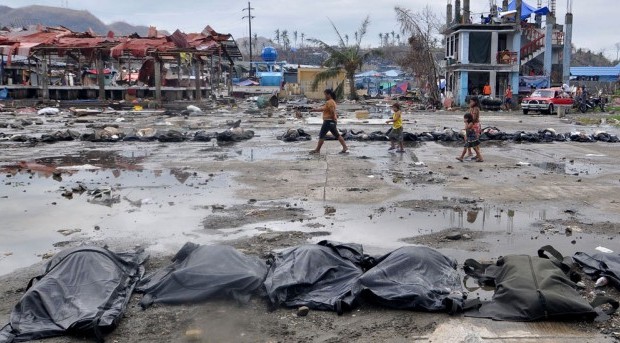Burying the dead no easy job

Nearly nine out of 10 fatalities in the onslaught of Supertyphoon “Yolanda” have remained unidentified more than a month after the storm hit the country, according to an official advisory. INQUIRER FILE PHOTO
TACLOBAN CITY—Theirs is not an easy job but, they are determined to do it.
They are the 30 men who, despite the rains that have been plaguing this already sodden city since Christmas, are tasked with burying more than 700 of the 1,400 unidentified bodies that have been left lying on the grounds of the health center in Suhi village here since Supertyphoon “Yolanda” struck nearly two months ago.
The burial of the unidentified typhoon victims was not decided until early last week, long after their DNA samples had been taken and each body tagged and numbered for future identification by relatives who might come looking for them.
The city government blamed the delay on bad weather, but Health Secretary Enrique Ona ordered quick action and to finish the burial by this week.
Article continues after this advertisement
Expediting burial
Article continues after this advertisementWeather permitting, the city government could do the job, City Administrator Tecson John Lim said.
“By Tuesday, [we hope], we can finish the burial,” Lim said.
In Manila, former Sen. Panfilo Lacson, now overseer of the government’s rehabilitation program for communities destroyed by Yolanda, said the burial would be finished on Tuesday.
Lacson said Health Undersecretary Janet Garin was supervising the burial of the bodies in a temporary mass grave in Suhi.
“She deployed additional personnel. [The Department of Public Works and Highways] sent additional backhoes and payloaders to [expedite] the mass burial. They [planned] to process and bury 300 [bodies on Saturday],” Lacson said.
Communications Secretary Herminio Coloma later confirmed that 300 bodies were buried on Saturday.
Paid ‘volunteers’
The 30 men in Suhi have been working since Thursday. Wearing operating-room-gown-like clothes, gloves and masks, they bury bodies in a pit 4.5 meters deep and 40 meters long.
The men said they were volunteers, but Lim said they were being paid P500 a day, with the city government and the Department of Social Welfare and Development (DSWD) splitting the cost between them.
The men described their task as “just a regular job.”
“We know that these are people, victims of Yolanda. We were tasked to bury them here, so we are just doing our job,” said Francis Retana, 24, a resident of the nearby village of Camansihay.
For three days now, Retana and his coworkers, along with with 30 soldiers from the Philippine Army’s 8th Infantry Division, have been burying bodies.
There were 736 bodies in black body bags on the ground. The men have buried more than 400 bodies.
Unpleasant job
Dr. Siobhan Ruddel, of the World Health Organization- Western Pacific Region, commended the men for undertaking the job.
“It’s not a pleasant job but they are doing it the best way they can,” Ruddel said.
The corpses, in black bags donated by the Department of Health, are laid side by side and covered with tarpaulin donated by the Office of the United Nations High Commissioner for Refugees. Then a payloader covers the pit with earth.
A 17-year-old boy, the youngest of the workers, said he did not feel anything when he picked up a body for burial.
“This is just a job. I am not scared. They are dead,” he said. With a report from Michael Lim Ubac in Manila
RELATED STORIES:
9 out of 10 ‘Yolanda’ deaths still unidentified
No end to ‘Yolanda’ victims’ woes